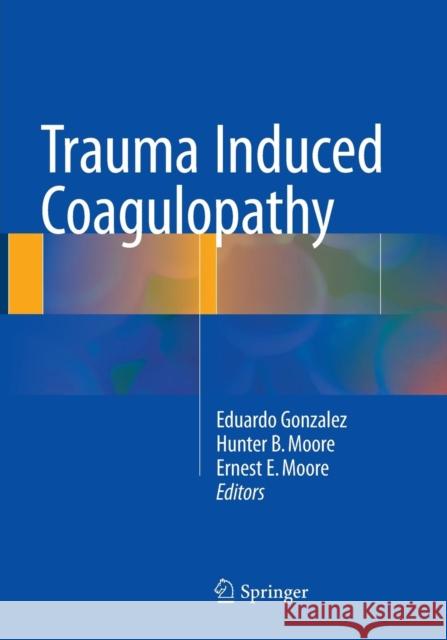Trauma Induced Coagulopathy » książka



Trauma Induced Coagulopathy
ISBN-13: 9783319803227 / Angielski / Miękka / 2018 / 601 str.
Trauma Induced Coagulopathy
ISBN-13: 9783319803227 / Angielski / Miękka / 2018 / 601 str.
(netto: 458,96 VAT: 5%)
Najniższa cena z 30 dni: 462,63
ok. 22 dni roboczych.
Darmowa dostawa!
"This is a collection of reviews describing the most important early complication of injury. ... Senior trainees, basic scientists seeking clinical connection, and surgeons, particularly those in academic trauma practice, are an appropriate audience for this book from international authorities. ... This is an important contribution that will guide senior clinicians and basic scientists seeking to better define this important clinical problem. The editors have been careful to assemble rigorous reviews that indicate the strengths and limitations of contemporary evidence." (David J. Dries, Doody's Book Reviews, August, 2016)
Trauma Induced Coagulopathy
Eduardo Gonzalez, Hunter B. Moore, Ernest E. Moore
Table of Contents
· Foreword
Kenneth Mann
· Preface
Ernest E. Moore, Hunter B. Moore, Eduardo Gonzalez
· Introduction: Historical Perspective: History of Trauma Induced Coagulopathy
Ernest E. Moore, Eduardo Gonzalez, Hunter B. Moore
Part 1: Physiology of Hemostasis
Chapter 1: Cell-Mediated Hemostasis
Maureane Hoffman
Chapter 2: Antithrombin Contributions to Physiological Hemostasis and Thrombosis Prevention, and its Dysregulation in Trauma and TIC
Susan C. Bock
Chapter 3: Physiology of Hemostasis: Plasmin-antiplasmin system
Nicola J Mutch, Nuala A Booth
Part 2: Pathogenesis of Trauma Induced Coagulopathy
Chapter 4: Thrombin Formation
Shekhar Kumar, Sriram Krishnaswamy
Chapter 5: Fibrinogen
Eduardo Gonzalez, Ernest E. Moore, Hunter B. Moore
Chapter 6: Activated Protein C
Mitchell Jay Cohen, Benjamin M. Howard
Chapter 7: Pathogenesis of Trauma Induced Coagulopathy: The Endothelium
Pär I. Johansson, Sisse R. Ostrowski
Chapter 8: Platelets
Scott L. Diamond
Chapter 9: Fibrinolysis
Hunter B. Moore, Ernest E. Moore, Eduardo Gonzalez
Chapter 10: Neutrophils, Inflammation and Innate Immunity in Trauma-Induced Coagulopathy
Christopher D. Barrett, Michael B. Yaffe
Chapter 11: DAMPs: Damage-Associated Molecular Pattern Molecules in Hemostasis
Charles T. Esmon
<
Chapter 12: The Complement System and Coagulation
Narcis I. Popescu, Florea Lupu
Chapter 13: Disseminated Intravascular Coagulation
Satoshi Gando
Part 3: Coagulation Assessment in Trauma Induced Coagulopathy
Chapter 14: Prothrombin and Partial Thromboplastin Time
Ruchika Goel, Paul M Ness
Chapter 15: Fibrinogen Assays
Christoph J. Schlimp, Herbert Schöchl
Chapter 16: Platelet Aggregometry
Taizo Nakano, Jorge Di Paola
Chapter 17: Thrombelastography
Eduardo Gonzalez, Ernest E. Moore, Hunter B. Moore
Chapter 18: Rotational Thromboelastometry (ROTEM®)
Klaus Görlinger, Daniel Dirkmann, Alexander A. Hanke
Part 4: Management of Trauma Induced Coagulopathy
Chapter 19: Red Blood Cell: Manufacture, Storage, and Transfusion
F. Bernadette West, Marguerite R. Kelher, Christopher C. Silliman
Chapter 20: Plasma Transfusion
Ryan A. Lawless, John B. Holcomb
Chapter 21: Cryoprecipitate Transfusion
Jeannie L. Callum, Bartolomeu Nascimento
Chapter 22: The Evolving Role of Platelets in Trauma Care
Andrew P. Cap, Todd Getz, Philip Spinella, Heather Pidcoke
Chapter 23: Massive Transfusion Protocols
Alexis M. Moren, Samantha J. Underwood, Martin A. Schreiber
Chapter 24: Fibrinogen and Clotting Factor Replacement
Massimo Franchini
Chapter 25: Anti-Fibrinolytics
Dominik F. Draxler, Robert L. Medcalf, Russell L. Gruen
Part 5: Post-injury Hypercoagulability
Chapter 26: Venous Thromboembolism
Steven R. Shackford, C. Beth Sise
Chapter 27: Congenital and Acquired Hypercoagulable States
Joseph Emmerich
Part 6: Organ-specific Coagulopathy
Chapter 28: Coagulopathy in Traumatic Brain Injury (TBI)Marc Maegele
Chapter 29: Liver Disease
Shahzaib Ahmad, Beverly J Hunt
Chapter 30: Hemostatic Abnormalities in Renal Disease
Michael P. Chapman, Anirban Banerjee, Ernest E. Moore
Part 7: Trauma Induced Coagulopathy in Special Populations
Chapter 31: Pediatrics
Robert I. Parker
Philippe de Moerloose, T. Marchetti, A. Casini
Chapter 33: Management of Chronically Anticoagulated Patients
Jerrold H. Levy
Part 8: Research of Trauma Induced Coagulopathy
Chapter 34: Animal Models
Ted Bambakidis, Martin Sillesen, Hasan B. Alam
Chapter 35: Mathematical Models of Hemostasis
Keith B. Neeves, Karin Leiderman
Ernest E. Moore, MD is Editor, Journal of Trauma and Acute Care Surgery (LWW)
This text is aimed at defining the current concepts that define trauma induced coagulopathy by critically analyzing the most up-to-date studies from a clinical and basic science perspective. It will serve as a reference source for any clinician interested in reviewing the pathophysiology, diagnosis, and management of the coagulopathic trauma patient, and the data that supports it. By meticulously describing the methodology of most traditional as well as state of the art coagulation assays the reader will have full understanding of the tests that are used to study trauma induced coagulopathy. The evolving use of blood products as well as recently introduced hemostatic medications are reviewed in detail.
1997-2026 DolnySlask.com Agencja Internetowa
KrainaKsiazek.PL - Księgarnia Internetowa









